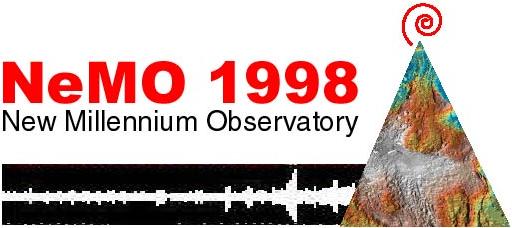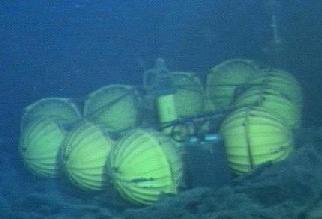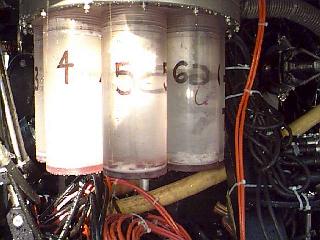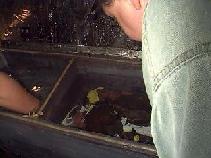WHAT'S NEW:
Other 1998 Axial Cruise Reports
(posted 8/13/98)
BACKGROUND:
Technology (ROV, ships, etc.)
Other 1998 Axial cruise reports
EXPEDITION:
Science Objectives
Calendar
Today's Science News
Participant Perspective
Teacher Logbook
EDUCATION:
Curriculum
Teacher Observations
Questions/Answers from sea
MULTIMEDIA:
(video clips, animations, sounds)

Logbook
September 1, 1998
September 1, 1998
Contents:
Science Report
Daily Science Update - early early early on September 1
Our current location = 45 55.6'N/129 58.8'W
| Photo of Rumbleometer stuck in new lava flow. Read report below how this confirmed an eruption and go to the Rumbleometer Story for the whole story. |

|
On the second dive on Aug 30, which totalled 28 hours on the bottom, we
collected
biological and basalt samples with the bio-box on the front of ROPOS and
deployed
bacterial traps.
(see teacher's logbook for a picture of the traps) We also found the missing
"rumbleometer" (the instrument
package
that had been deployed at Axial since the summer of 1997 but did not release
when it was supposed to in early August).
 Mid-way through the dive we located
a sulfide chimney (formed by mineral deposits around a high-temperature "smoker"
vent) that had previously been photographed by a camera tow in 1996 (so we know
it
was pre-existing before the 1998 eruption). The chimney is actively venting hot
water,
has lots of tube worms growing around it and is interesting because it is the
first
smoker vent found on the south rift zone. We named this chimney "castle" vent
because it is fantastically shaped - narrow near the bottom and very broad near
the
top with many individual spires on the top.
Mid-way through the dive we located
a sulfide chimney (formed by mineral deposits around a high-temperature "smoker"
vent) that had previously been photographed by a camera tow in 1996 (so we know
it
was pre-existing before the 1998 eruption). The chimney is actively venting hot
water,
has lots of tube worms growing around it and is interesting because it is the
first
smoker vent found on the south rift zone. We named this chimney "castle" vent
because it is fantastically shaped - narrow near the bottom and very broad near
the
top with many individual spires on the top.
ROPOS's third dive was relatively
 short
(Aug 31, 7 hours) because it was specifically configured for and focused on
water and
biological sampling with the
"slurp" sampler at only a few vent sites and
deploying
additional bacterial traps. Each dive we change around some of the sampling and
instrumentation on ROPOS depending on the specific objectives of the dive.
short
(Aug 31, 7 hours) because it was specifically configured for and focused on
water and
biological sampling with the
"slurp" sampler at only a few vent sites and
deploying
additional bacterial traps. Each dive we change around some of the sampling and
instrumentation on ROPOS depending on the specific objectives of the dive.
After a 5 hour turn around, ROPOS decended for it's fourth dive, which we are currently conducting. This one will probably be another long one including more Imagenex sonar surveying, and additional slurp (vent water and/or bacterial mats) and biological samples. We hope to get some samples of the castle chimney too near the end of the dive. All of our first 4 dives have been on the upper south rift zone within an area about 3 km north-south and 1 km east-west. In between ROPOS dives we have been doing CTD casts for biological and chemical samples of the hydrothermal plumes above the seafloor, and rockcoring - which obtains samples of the basalt on the seafloor for later chemical analysis.
We now are convinced that we see new (1998) lava on the seafloor where we have been diving. It took us a while to be convinced because the new lava does not look "pristine" (black, shiny, and without any sediment) the way other new flows have looked at other eruption sites we have visited in the last few years. Instead it is covered almost everywhere with an orange, slimey-looking deposit that appears to be derived from bacterial growth directly on the new lava as it cools. This is the first time we have seen this kind of coating on a new flow and we're still trying to figure it out (we've taken samples of it to examine). We're convinced it is new because if we wipe off the slime, the lava is shiny and black underneath, it is still venting warm water in many places with bacterial mats growing around the vents. We've seen many very well-defined "contacts" between older lavas and the new lavas and the change is striking, from lava with sediment and deep-sea animals colonized on it, to the orange coated new flows devoid of any animals (it takes months to years for deep-sea animals to colonize new flows). By mapping out these contacts with ROPOS we will be able to make a map of the extent of the new lava flow. So far we haven't covered much ground yet, but over the next 3 weeks we'll be piecing together that picture.
The biology really helps doing geologic mapping in this case. On the first dive we were looking for a large field of tube worms that had been visited with ROPOS last summer, but we couldn't find it. Now we are convinced that it is completely covered with new lava and obliterated without a trace! There are still tube worms in other areas on the older lavas that have not been covered up (in case you are wondering how we have tube worm samples!). The "missing" rumbleometer may even be a data point on our geologic map, because it may be surrounded by new lava, instead of collapsed into older shelly lava, as we first thought. We're still not sure of this, but that may explain why it did not release when it was supposed to! Should make for a great data-set if we can recover it later.
How extensive is this new lava flow? Where exactly did it erupt out of? How far down the rift zone did the eruption extend? How does the pattern of earthquakes relate to the eruption sites? These are all questions we hope to answer in the next 3 weeks.
Listing of all Science News postings
Life at Sea: Participant Perspective
Keith Shepherd
General Manager, Canadian Scientific Submersible Facility
 Watching the ocean, there are never two days when it looks the same.
Throughout
the day it is always changing. It is hard to pause and observe the waves, clouds
and life during our busy
ROPOS lives.
I have always been amazed and fascinated by the ocean floor and its diversity.
Particularly fascinating are the hydrothermal vents, and the associated biology
and geology. I have worked in these areas for over 16 years, and the
more I
learn, the more fascinating it becomes. It is a pleasure and a privilege to work
with so many researchers, who are each so dedicated and committed to
wringing
the most out of the huge amount of data ROPOS and its support team provide.
Working with these scientists helps keep the ROPOS team focused and the morale
high.
Watching the ocean, there are never two days when it looks the same.
Throughout
the day it is always changing. It is hard to pause and observe the waves, clouds
and life during our busy
ROPOS lives.
I have always been amazed and fascinated by the ocean floor and its diversity.
Particularly fascinating are the hydrothermal vents, and the associated biology
and geology. I have worked in these areas for over 16 years, and the
more I
learn, the more fascinating it becomes. It is a pleasure and a privilege to work
with so many researchers, who are each so dedicated and committed to
wringing
the most out of the huge amount of data ROPOS and its support team provide.
Working with these scientists helps keep the ROPOS team focused and the morale
high.
Ahh, the ROPOS team. I cannot say enough about the men who are committed to keeping ROPOS on the leading edge. It takes great personal and family sacrifice to spend so much time with ROPOS at sea, and many long days and weeks on shore to maintain, repair and prepare for the next mission. ROPOS would not be the unparalleled tool it is today without the hard work and dedication of these people, and support of their families. I am very lucky to be involved in such a challenging and interesting pursuit.
Keith Shepherd (chief ROPOS pilot)
Listing of all Perspectives postings
Teacher At Sea Logbook
September 1 - 0900 hours
Good news and bad news. First the sun got too low in the sky to allow us to the photography of the recovery of ROPOS. The bad news is that we'll have to do it later and the sharks will be hungrier. Also, my wife now knows what I'm up to.
I had a quiet night because we brought ROPOS on board just at sunset and the crews went to work preparing the craft for another dive that began in the middle of the night. This is scheduled to be a long dive, probably lasting more than 24 hours. Up to this point we are scanning the seafloor to improve maps of the area. About noon we will put ROPOS on the bottom and begin our marking and sampling again
 It may have been quiet in the operations center, but the biology lab was alive
with activity. ROPOS brought sampling baskets full of organisms (photo shows Criag Moyer examining the "biobox" (S.Merle/NOAA)) picked up on
the sea floor. Several different methods are used for collecting organisms in
the vent area. You have already heard about and seen the bacteria traps. After
only a few hours in the vent waters these were full of bacteria. Larger
organisms, like the tube worms, scale worms, and limpets are not trapped. They
are either picked off the rocks by the claw arm on ROPOS, or they are scooped up
in a shovel-like device known as Pacman. If we post a picture of Pacman you'll
see how the device got its name. One other device that was very successful was
what is called the slurp gun. The slurp gun
It may have been quiet in the operations center, but the biology lab was alive
with activity. ROPOS brought sampling baskets full of organisms (photo shows Criag Moyer examining the "biobox" (S.Merle/NOAA)) picked up on
the sea floor. Several different methods are used for collecting organisms in
the vent area. You have already heard about and seen the bacteria traps. After
only a few hours in the vent waters these were full of bacteria. Larger
organisms, like the tube worms, scale worms, and limpets are not trapped. They
are either picked off the rocks by the claw arm on ROPOS, or they are scooped up
in a shovel-like device known as Pacman. If we post a picture of Pacman you'll
see how the device got its name. One other device that was very successful was
what is called the slurp gun. The slurp gun
 is like a big turkey baster (see photo at left ROPOS/1998). It
simply sucks up the water and any organisms into big holding canisters in which
they can be returned to the surface. Within seconds of landing the ROPOS on the
deck we were able to get photographs of a rare palm worm attached to the inside
of the collection canister. I still can't believe I'm actually doing this.
is like a big turkey baster (see photo at left ROPOS/1998). It
simply sucks up the water and any organisms into big holding canisters in which
they can be returned to the surface. Within seconds of landing the ROPOS on the
deck we were able to get photographs of a rare palm worm attached to the inside
of the collection canister. I still can't believe I'm actually doing this.
0400 hrs-
The wind has come up a bit today, but still great conditions out here. We saw several new group of animals on the sea floor today. We found some of the tubeworms that seemed to have been missing from the last voyage. There seems to be some evidence of a whole new vent trend that has not yet been identified. ROPOS is on the bottom, currently placing bacteria traps in some new locations.
I saw several large spider crabs today and asked about their distribution. One of the biologist informed me that this species of crab is found widely distributed throughout the Pacific basin, but that the females and juveniles tend to cluster around the vents, presumably because there is more food here. The males, who are highly aggressive toward other males, migrate further from the vents. This may be to prevent competition for scarce resources. Sorry guys. The truth is that in biology and sinking ships, it's still women and children first. The males are simply more expendable. It's not right, but it's the way it is. Williamson's Soggy Sophistry for today. Stay tuned for pictures of some of the new organisms we photographed today.
Fact for the day:
The pressure on the organisms at the ridge is about 153 atmospheres. For those of you who think in pounds per square inch, this converts to every square inch of the ROPOS, the organisms, and the sea floor being pressed on by approximately 2250 pounds.
For more information on PRESSURE, visit the NeMO Education Learning Material site for the Pressure Primer.
Logbook of all Teacher At Sea postings
Question/Answer of the Day
September 1, 1998
Question:
If there was a plume(s) on the jan-feb eruption, did they stick around long enough to be studied? How big was the plume and does the plume hang around, move and is there a preferred direction of circulation within a plume? What is the effect of the plume fallout on the adjacent body of water?Jeff Goodrich, Environmental Middle School
Answer:

|
Area map of Axial region showing the plume represented by light attenuation anomalies. (click map for larger version). Light attenuation is measured with the CTD instrument. See Preliminary Results from the Wecoma Event Response Cruise, February 1998. (map: S.Walker/NOAA) |
All Questions/Answers from sea
Send Your Question to NeMO
Back to Calendar